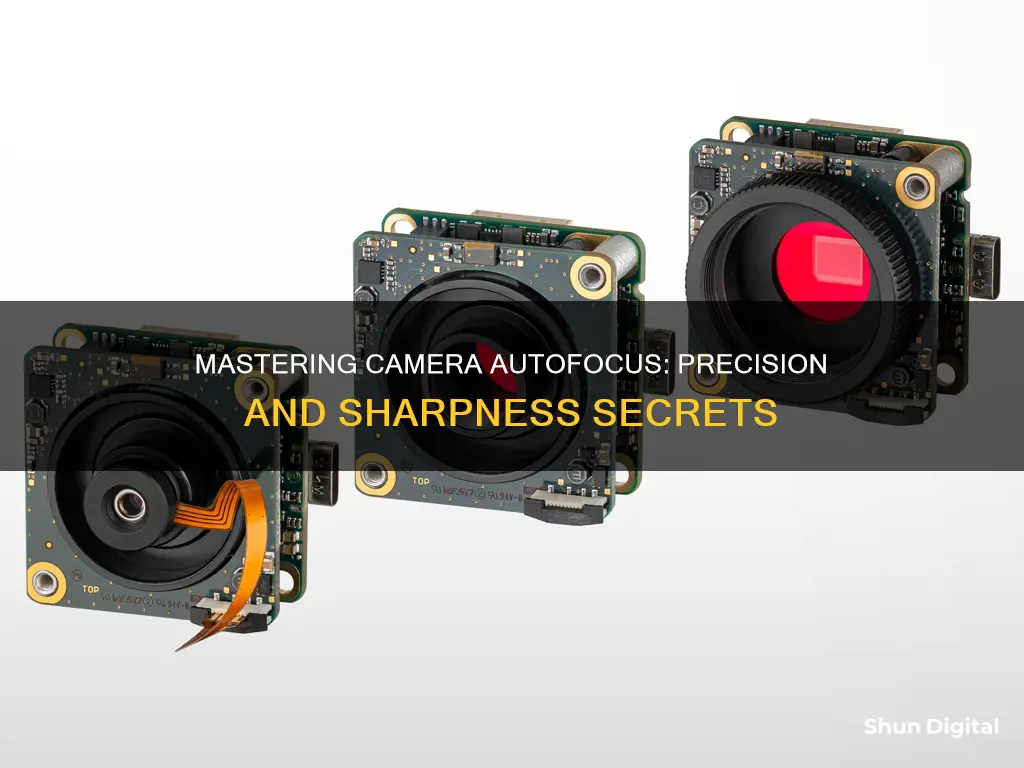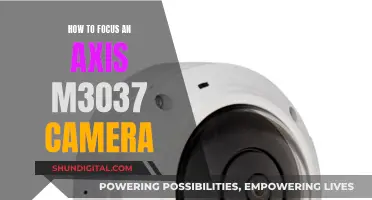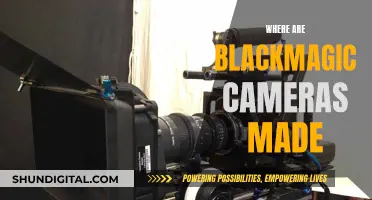
The autofocus system in a camera is a complex process that has been improved and innovated upon since the first mass-produced autofocus camera, the Konica C35 AF, was released in 1977. The autofocus system in modern cameras can be either active or passive. Active autofocus systems measure the distance to the subject independently of the optical system and subsequently adjust the focus. On the other hand, passive autofocus systems determine correct focus by performing an analysis of the image entering the optical system.
Passive autofocus systems are the most common type of autofocus in modern cameras. They can be further divided into phase detection and contrast detection. Phase detection autofocus systems work by dividing the incoming light into pairs of images and comparing them. Contrast detection autofocus systems, on the other hand, measure the contrast within a sensor field through the lens.
The autofocus system in a camera works in tandem with autofocus sensors. These sensors are laid out in arrays across the image's field of view. Each sensor measures the relative focus by assessing changes in contrast at its respective point in the image. The autofocus processor then makes small changes in the focusing distance and assesses whether and by how much focus has improved. This process is repeated until satisfactory focus is achieved.
| Characteristics | Values |
|---|---|
| Type of autofocus | Phase detection, contrast detection, active AF, passive AF |
| Process | Camera assesses changes in contrast at its respective point in the image, where maximal contrast is assumed to correspond to maximal sharpness |
| Number of autofocus points | Varies from model to model; entry-level models may feature fewer than a dozen, whereas top-tier cameras tend to have autofocus points in the three-digit range |
| Type of autofocus points | Cross-type sensors, vertical line sensors |
| Flexibility | Depends on the number, position and type of autofocus points |
| Autofocus modes | One-shot focusing, continuous focusing, AI Servo, AF-C |
| Autofocus area modes | Single-point autofocus, dynamic or tracking autofocus, group area autofocus, face and eye detection, auto-area autofocus |
| Autofocus assist beam | Uses visible or infrared light to help a camera's autofocus sensors when there isn't enough ambient light |

Active vs Passive AF
Autofocus (AF) works in two ways: using contrast sensors within the camera (passive AF) or by emitting a signal to illuminate or estimate the distance to the subject (active AF).
Active AF
Active AF systems were used in the early days of autofocus technology. They relied on the camera transmitting an ultrasonic or infrared signal toward the subject. The subject would reflect the sound or light back to the camera’s focus sensor. By calculating the time it took for this return journey, the camera could work out how far away the subject was.
Passive AF
Passive AF is the choice of most cameras today. It has two systems: Phase Detection and Contrast Detection.
Phase Detection
Phase detection is the system most commonly found on DSLR cameras. Light enters the lens of a DSLR and strikes a mirror that is angled in front of the sensor or film. That light is reflected up into a prism and then toward the viewfinder at the back of the camera. However, a small amount of light passes through that mirror, strikes another mirror, and is reflected down toward the autofocus sensor at the bottom of the camera.
The autofocus sensor contains two or more image sensors with microlenses above them. These tiny sensors create the camera’s autofocus points. The first passive autofocus cameras used to have one central focus point. Today, cameras can have dozens of selectable focus points.
So, how does this autofocus sensor work? In simple terms, phase detection works by dividing that incoming light into pairs of images and comparing them. The light is divided as it passes through the transparent part of the main mirror. The two distinct images are directed downward to the autofocus sensor, where the two images are compared and their positional relationship evaluated. A computer inside the camera evaluates the signal from the autofocus sensor and commands the lens to adjust the focusing elements inside the lens until the two images appear identical. Once the two images match, the image is in focus.
Contrast Detection
Contrast detection is the system used commonly by mirrorless cameras, point-and-shoot cameras, DSLR cameras in live view, and smartphone cameras; basically, any camera without a mirror in use.
As you may have noticed, the phase detection systems are complex and have many components. Contrast detection is much simpler and it uses the light falling on the main sensor to provide focus. This gives contrast detection one advantage over phase detection: the number of autofocus points. With phase detection, the number of points is based on the design of the mirror and how many autofocus sensors live below that mirror. With contrast detection, the camera can have an almost unlimited number of focus points. Some modern cameras have touchscreens where the camera will focus on any point in the image that you designate, with the touch of a finger.
How does it work? Well, the camera commands the focus element of the lens to move while it reads any decrease in the intensity of light on a pixel or group of pixels. The maximum intensity indicates the region of sharpest focus. While simplicity is the advantage of this system, the downside is that the camera must constantly evaluate images in order to achieve focus. When the light hits the sensor for the first time, the camera has no idea if the light is showing its maximum intensity or not until it changes the position of the lens to vary that intensity.
This is called “hunting”. Those who have older point-and-shoot cameras may remember waiting for the lens to find focus while the action in the scene passed them by. Luckily, technology surrounding contrast detection autofocus is always improving, and today’s mirrorless cameras and point-and-shoots have the ability to focus extremely fast.
Burst Mode: Capturing Fast-Paced Action with Your Camera
You may want to see also

Phase Detection
The autofocus sensor contains two or more image sensors with microlenses above them. These tiny sensors create the camera's autofocus points. The autofocus sensor works by dividing the incoming light so that it passes through that transparent part of the main mirror, where that area acts like a beam splitter. The two distinct images are directed downward to the autofocus sensor, where the two images are compared and their positional relationship evaluated. A computer inside the camera evaluates the signal from the autofocus sensor and commands the lens to adjust the focusing elements inside the lens until the two images appear identical. Once the two images match, the image is in focus.
The Evolution of Photography: First Camera Invention
You may want to see also

Contrast Detection
However, contrast detection autofocus also has some drawbacks. It requires the camera to process more data, meaning it generally takes longer to lock focus and is not suitable for tracking moving subjects. It also requires the camera to constantly evaluate images to achieve focus, which can be slow.
Activating Standby Mode: A Simple Guide for Your Camera
You may want to see also

AF Assist Beam
An AF Assist Beam is a method of active autofocus that uses a visible or infrared beam of light to help autofocus sensors detect a subject. This is particularly useful in low-light conditions or when the subject has insufficient contrast for autofocus.
AF Assist Illumination is a beam of light projected from the camera body or an external flash. It helps the camera autofocus in dark conditions. The beam can be a dim light projected from the camera body, a high-speed pulse from the camera's pop-up flash, or a red light pattern projected by an external flash mounted on the camera.
AF Assist lamps are usually built into the camera body above the lens mount. They light up the subject area while the camera focuses but only work at very short distances due to their low power output. It is important that they are only lit while the camera focuses as they can cause the camera to read a scene as brighter than it is, leading to unwanted underexposure.
How to Ensure Your Camera Charges Efficiently While Switched Off
You may want to see also

Focus Points
The number of autofocus points varies across camera models, with some offering 9 points, while others provide 11 or even 51 points. This feature is not limited to expensive, high-end cameras; even some point-and-shoot cameras have autofocus points. The advantage of having more autofocus points is the increased flexibility in selecting what to focus on. With a higher number of AF points, photographers can easily track moving subjects and compose their shots more creatively.
The autofocus points are not just about choosing where to focus; they also play a role in metering and exposure. Many cameras connect the autofocus points to their metering systems, allowing them to determine the appropriate exposure based on the chosen autofocus point, which is often the main subject of the photograph. This integration between focusing and metering ensures that the camera's settings are optimised for the chosen subject, resulting in better-exposed images.
When using autofocus, photographers have the option to let the camera choose the AF point or manually select it themselves. The automatic mode uses algorithms to identify the main subject, usually the largest or fastest-moving object in the frame. However, this mode may not always align with the photographer's intention. Therefore, the ability to manually select the AF point is crucial, especially when the desired focus area is not in the centre or when there are multiple objects in the frame.
To manually select an AF point, photographers need to consult their camera's manual to identify the designated button, often located on the back-right of the camera. This button activates the AF point selection, allowing users to toggle between different points using arrow keys or wheels. By mastering this feature, photographers gain greater control over their images, ensuring that the desired subjects are in sharp focus, regardless of their position in the frame.
In conclusion, autofocus points are a powerful tool that gives photographers the ability to direct the camera's attention, mimic manual focus, and fine-tune the focus of their images. By understanding how to use these focus points effectively, photographers can enhance their compositions, capture moving subjects, and ensure their desired subjects are always in sharp focus.
Charging the A7 Camera: A Step-by-Step Guide
You may want to see also
Frequently asked questions
Autofocus (AF) is when the camera system drives a motor to move elements in your lens to change focus.
Autofocus uses a sensor, a control system, and a motor to focus on a selected point or area. There are two main types of autofocus systems: phase detection and contrast detection. Phase detection is faster and better at tracking moving subjects, while contrast detection is more precise as it directly measures data from your camera sensor.
Autofocus is more convenient, faster, and often more accurate than manual focus, especially for tracking moving subjects.
There are active, passive, and hybrid autofocus systems. Active AF systems measure distance to the subject independently, while passive AF systems analyse the image entering the optical system. Hybrid systems combine two or more methods to increase reliability and accuracy.
The autofocus system assesses changes in contrast at its respective point in the image. When maximal contrast is achieved, the image is in focus.







